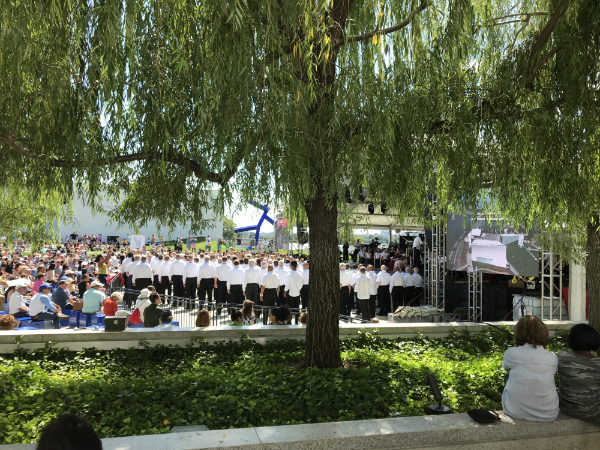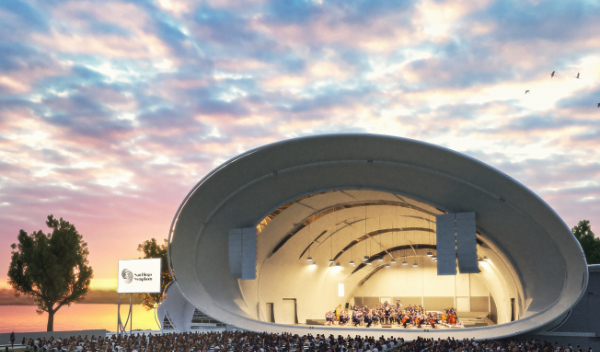Reaching Completion in Washington
It was an eventful September at the Kennedy Center, beginning with the conclusion of the National Symphony Orchestra negotiations. The four-year agreement, ratified by musicians on September 11, includes an overall increase in base wages of 8.5% as well as implementing a new employer contribution of 1.5% to their 403(b) retirement plan.
The NSO negotiations finished just as the Kennedy Center’s first-ever expansion, named the REACH (for renew, experience, activate, create, and honor), publicly opened with a 16-day “Creativity in Action” Festival. For the project, the Kennedy Center had chosen Columbia University Professor Steven Holl as the architect. (Note: See “Orchestra Newslets” in the March 2015 issue.) Holl’s previous works include Houston’s Museum of Fine Arts, Dallas’s Stretto House, and the University of Minnesota’s Ralph Rapson Hall. The finished REACH includes three indoor pavilions, an outdoor stage with a video wall, 130,000 square feet of landscaping and gardens, a cafe, and a pedestrian bridge that connects the Center with a path to the National Mall and monuments.
The Opening Festival saw performances, presentations, workshops, displays, and other contributions from a wide variety of art forms, including chamber music, jazz, comedy, theater, dance, hip hop, electronica/DJ culture, indigenous cultures, film, and visual arts. Some notable participants included Mason Bates, Tiler Peck, the Kronos Quartet, Roomful of Teeth, Esperanza Spalding, Wayne Shorter, and Renée Fleming. The National Symphony Orchestra presented two outdoor performances, Beethoven’s Ninth Symphony as well as a program with Alan Menken and other Broadway celebrities. The Washington National Opera, one of the Kennedy Center Opera House Orchestra’s two employers, screened a 2013 performance of Showboat on the video wall. KCOHO and NSO musicians were also featured in chamber music performances throughout the festival.

The National Symphony Orchestra performs Beethoven (with an aerial view of the REACH on the screen)
Photo credit: Peter de Boor
The REACH was funded through a multi-year development effort that raised over $250 million, with a portion of that being set aside for artistic operations. Kennedy Center Chairman David Rubenstein provided an anchor gift of $50 million. An estimated 100,000 people attended events during the opening festival. Few specific programs and events after the opening of the REACH have been publicly announced. While some hope the Kennedy Center will be able to create novel arts experiences in the new space, there is some skepticism among arts critics. As the Washington Post’s Philip Kennicott wrote, “If [in five years] the majority of its new spaces are active and throwing off sparks, it will be a success. If not, the problem will almost certainly be a lack of institutional foresight rather than architectural planning.”
Lyric’s New Leader
Spanish-born Italian conductor Enrique Mazzola has been announced as music director designate of the Lyric Opera of Chicago. Sir Andrew Davis, who is about to open his 20th season as music director, will complete his tenure at the end of the 2020/2021 season, and Mazzola will take the helm for the 2021/2022 season. Mazzola has conducted two bel canto operas at Lyric in 2016 and 2017 and is beginning an early Verdi series at Lyric this fall with Luisa Miller. Lyric Opera management has cited the orchestra’s conductor surveys as integral to their music director search.
At the all-company announcement meeting on September 12, Davis spoke movingly about his love for Lyric and his confidence that Mazzola “will continue the tradition of the Lyric Opera family.” Mazzola said he felt “amore a prima vista” for Lyric and praised the artistic forces of the company, especially “a formidable orchestra, able to play in the most virtuosic way all different repertoire, from the classical to the contemporary.” As music director, Mazzola will make Chicago his home; “I really want to listen to Chicago… I want to feel Chicago.” Luckily he already loves deep-dish pizza!
San Diego’s New Summer Venue
The San Diego Symphony announced that its new concert venue, Bayside Performance Park, will open in the summer of 2020. Construction for the $45-million project began on September 16. The venue will function as a dual-purpose outdoor waterfront performance space and active public park, the only one of its kind on the west coast.

An artist’s rendering of the Bayside Performance Park stage
Photo credit: Courtesy of the San Diego Symphony Orchestra
Bayside Performance Park will boast many features, including a covered, 13,000-square-foot stage with ancillary back-of-house facilities, and a patio at the back of the performance stage with stunning views of the bay, which will be open for public use during non-event hours. In addition, improved and environmentally sustainable landscaping, coupled with unobstructed, terraced, variable seating for 2,000 to 10,000, will enhance the overall concert experience. The stage’s acoustic design, created by Charles Salter Acoustics of San Francisco and sound designer/consultant Shawn Murphy, will feature a Meyer Constellation System, which allows for adjustable, electronically enhanced acoustics to accommodate a variety of performances, including orchestral, chamber music, Broadway musicals, and popular genres and artists. Furthermore, the San Diego Symphony will offer some reduced-price tickets to every concert and present free educational events, four free public concerts, and open SDSO rehearsals to ensure that everyone in the community has access to Bayside Performance Park events.
Said San Diego Symphony CEO Martha Gilmer, “We are elated to bring the most iconic waterfront concert venue on the west coast. The high artistic quality of our orchestra will now be supported by an equally superior performance venue. The San Diego Symphony looks forward to sharing and celebrating our gift to the community for decades to come.





